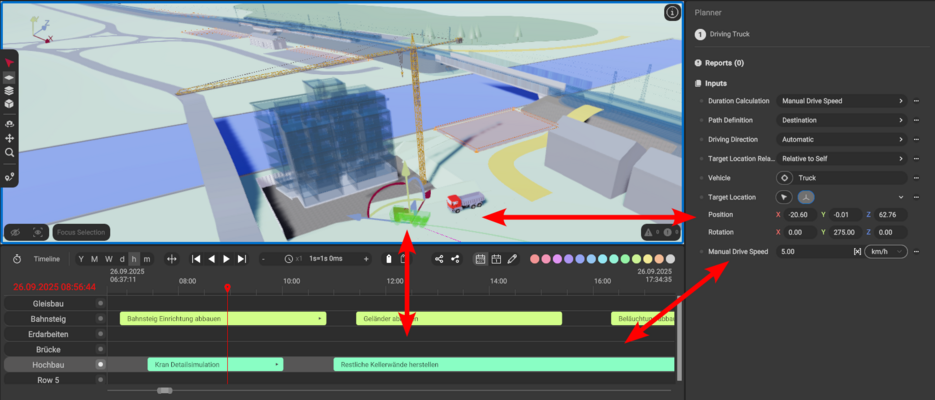Bridging From 2D-Diagrams to 4D-Scenes
27.03.2025Innovate how we think by creating a smooth transition from 2D diagrammatic representations to 3D visuals and their evolution over time.
Background
Complex spatiotemporal models, commonly encountered in fields such as 3D animation, Computer-Aided Manufacturing (CAM), and recent advancements in construction planning, are typically developed using a combination of two-dimensional interfaces (e.g., Gantt charts, timelines, dope sheets, list-based UI widgets and node graphs) and three-dimensional visualizations. The effective usability of these systems strongly depends on the seamless transition between these types of visual representations, referred to as the modalities flow.
Objectives
This work employs a user-centered engineering approach to design, prototyle, and evaluate an intuitive and efficient interaction paradigm between two-dimensional representations (specifically Gantt charts and list-based UIs) and their corresponding three-dimensional visual representations (3D viewport) over time. The goal is to identify and define an optimal flow of visualisation and interaction modalities within the context of construction process planning.
Expectations
- Literature Review: Conduct an extensive review of relevant usability methods and established best practices within user-centered engineering.
- Conceptual Design: Develop a comprehensive conceptual design for optimal modality transitions between 2D and 3D/4D visualizations, including:
- Gathering user goals and stories to determine required modifiable and encoded information.
- Defining how different information types are visualized and how users can interact with and modify these visualizations (e.g., through gizmos or widgets).
- Discussing how the various inputs in one representation may or may not influence the model representations in other views, particularly regarding process and object selections/filtering
- Prototype Development: Implement a prototypical interface that embodies the conceptual design.
- Preliminary User Study: Conduct a small-scale qualitative study to gather user feedback and evaluate usability.
- Analysis and Documentation: Scientifically analyze user-study results and thoroughly document findings.
Recommended Starting Points (provided separately)
- M. Richter and M. Flückiger, User-Centred Engineering. Springer Berlin Heidelberg, 2014, https://doi.org/10.1007/978-3-662-43989-0
- J. Hong, et. al. “A Survey of Designs for Combined 2D+3D Visual Representations,” 2024, https://doi.org/10.48550/arXiv.2401.05438.
Supervision
Prof. Dr. Sebastian von Mammen
Yasin Raies, M.Sc., Building Information Innovator GmbH







